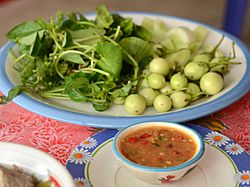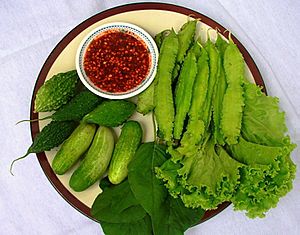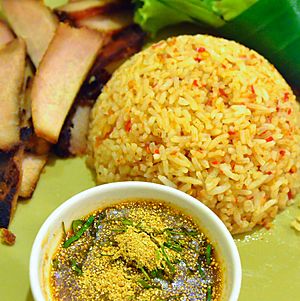Nam phrik facts for kids

Nam phrik kapi (foreground)
|
|
| Alternative names | น้ำพริก |
|---|---|
| Type | Dip or chili sauce |
| Place of origin | Thailand |
| Region or state | Southeast Asia |
| Created by | Thai people |
| Main ingredients | Chili peppers |
| Similar dishes | Ngapi yay, Lalab, Ulam (salad) |


Nam phrik (Thai: น้ำพริก) is a super spicy chili sauce or dip from Thailand. It's a really important part of Thai cuisine.
To make nam phrik, people usually pound fresh or dried chili peppers, garlic, shallots, and lime juice together. Often, they also add some kind of fish or shrimp paste. All these ingredients are traditionally crushed using a mortar and pestle. Then, they add salt or fish sauce to make it taste just right.
Nam phrik is usually served in small dishes next to the main meal. It's used as a condiment or a dip for foods that aren't very spicy on their own. This includes things like raw or boiled vegetables, fish, chicken, and other meats. The texture of nam phrik can be different depending on the type and where it's made. It can be runny like a liquid, thick like a paste, or even almost dry and crumbly.
Sometimes, the words nam phrik are also used to describe Thai curry pastes. For example, nam phrik kaeng som is the paste for kaeng som curry, and nam phrik kaeng phet is for kaeng phet (red curry).
A Taste of History
The first person from the Western world to write about nam phrik was Simon de la Loubère. He was a French ambassador who visited the Ayutthaya kingdom in Thailand way back in 1687–88. He wrote that it was a "mustard-like sauce" made with fermented crayfish, which they called kapi.
Even King Chulalongkorn, who was one of Thailand's greatest kings, loved nam phrik! When he traveled around Europe in 1907, he often said that he missed nam phrik the most, besides his omelets. David Thompson, a famous expert on Thai food, says that nam phrik is "at the very core of Thai cooking." It has been a main food for Thai people for a very long time.
Chili peppers actually came from the Americas. People there started growing them over 6,000 years ago! They probably arrived in Asia and Thailand in the 1500s. This happened when traders and explorers from Portugal brought them over. This exchange of plants and animals between the Old World and the New World is called the Columbian Exchange. Before chilies came along, Thai people used other spices like black pepper to make their food spicy.
Many Kinds of Nam Phrik
There are many different kinds of nam phrik! They change depending on the ingredients used, how they are made, and which part of Thailand they come from. Some might have tamarind, green mango, galangal, lemongrass, or even mushrooms. Some recipes even use frog! If fish paste is used, it can be made from dried, boiled, grilled, or salted fish, or even fish roe. In a region called Isan, a strong-flavored fermented fish sauce called pla ra is often used. Some types of nam phrik are even made sweet with sugar. A Thai cookbook from 1974 listed over 100 different recipes!
Here are some of the most common types:
- Nam phrik kapi (Thai: น้ำพริกกะปิ) is one of the most popular kinds, especially in central Thailand. It's made with fermented shrimp paste, lime, chilies, and often small pea eggplants. People often eat it with fried pla thu (a type of fish) and vegetables.
- Nam phrik kha (Thai: น้ำพริกข่า) is made with roasted chilies, garlic, galangal, and salt. This special northern Thai dip is often served with steamed mushrooms.
- Nam phrik kung siap (Thai: น้ำพริกกุ้งเสียบ) is a favorite in Southern Thailand, especially in Phuket and Krabi. It uses crispy smoked dried shrimp (kung siap), shallots, garlic, bird's eye chili, and shrimp paste. It's flavored with lime juice, palm sugar, and fish sauce.
- Nam phrik long ruea (Thai: น้ำพริกลงเรือ; meaning "In the boat chili paste") is a fancy fried nam phrik. It uses different fruits like Garcinia schomburgkiana and Solanum ferox, dried shrimp, sweet pork, and shrimp paste. Of course, it also has chilies, garlic, and sugar. It's eaten with salted duck egg, fresh greens, and sliced Zedoary (which is like white turmeric).
- Nam phrik maeng da (Thai: น้ำพริกแมงดา) gets its special taste from roasted and pounded maeng da. This is a type of Giant water bug (Lethocerus indicus).
- Nam phrik narok (Thai: น้ำพริกนรก) literally means "chili paste from hell" because it's super spicy! It's made with dried chilies, shrimp paste, catfish, shallots, garlic, fish sauce, and sugar.
- Nam phrik num (Thai: น้ำพริกหนุ่ม) is a thick northern Thai specialty. It's made from roasted green chilies, onion, and garlic. People usually eat it with vegetables, crispy pork cracklings, and sticky rice.
- Nam phrik ong (Thai: น้ำพริกอ่อง) is a traditional dish from northern Thailand. It's made with minced pork and tomato.
- Nam phrik phao (Thai: น้ำพริกเผา) is sweetened with sugar and includes roasted chilies and tamarind. It's popular as a spread on bread or toast. It's also used as an ingredient in dishes like tom yum soup or the Thai salad with squid called phla pla muek.
- Nam phrik pla ching chang (Thai: น้ำพริกปลาฉิ้งฉ้าง) is made from small, local anchovies (Stolephorus) that are popular in Phuket.
- Nam phrik pla ra (Thai: น้ำพriกปลาร้า) uses pla ra (fermented fish sauce) as one of its main ingredients. Like most nam phrik types, a little water is added if the mixture gets too thick.
- Nam phrik pla salat pon (น้ำพริกปลาสลาดป่น) is also called phrik pla salat pon. It's a type of nam phrik made with powdered, roasted, dry pla salat (a fish called Notopterus notopterus). The dry fish, red dry chili, and garlic are all roasted until they are crunchy. Shrimp paste and sugar are also added, and everything is pounded together. It's eaten with raw vegetables and is popular in Khorat.
- Nam phrik pla yang (Thai: น้ำพริกปลาย่าง) is mostly minced, grilled fish, usually pla chon. It's mixed with onion, garlic, powdered chili, tamarind, shrimp paste, fish sauce, and sugar.
- Nam phrik tai pla (น้ำพริกไตปลา) uses tai pla as one of its main ingredients. Tai pla is a sauce from southern Thai cooking made from the fermented insides of the short-bodied mackerel fish.
See also
 In Spanish: Nam phrik para niños
In Spanish: Nam phrik para niños



